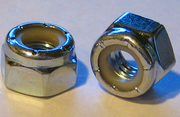
Locknut
Encyclopedia

Nut (hardware)
A nut is a type of hardware fastener with a threaded hole. Nuts are almost always used opposite a mating bolt to fasten a stack of parts together. The two partners are kept together by a combination of their threads' friction, a slight stretch of the bolt, and compression of the parts...
that resists loosening under vibrations and torque. Elastic stop nuts and prevailing torque nuts are of the particular type where some portion of the nut deforms elastically to provide a locking action. The first type used fiber instead of nylon and was invented in 1931.
Types
There are various kinds of specialised lock nuts, including:- Castellated nutCastellated nutA castellated nut, also called a castle nut or slotted nut, is a nut with slots cut into one end. The name comes from the nut’s resemblance to the crenellated parapet of a medieval castle....
- Distorted thread locknut
- Centerlock nut
- Elliptical offset locknut
- Toplock nut
- Interfering thread nutInterfering thread nutAn interfering thread nut is a type of locknut that has an over-sized root diameter. This creates an interference between the nut and the fastener, plastically deforming the threads on the fastener. Due to this deformation they are usually only used on permanent or semi-permanent installations.A...
- Tapered thread nut
- Jam nutJam nutA jam nut is a low profile type of nut, typically half as tall as a standard nut. It is commonly used as a type of locknut, where it is "jammed" up against a standard nut to lock the two in place...
- Jet nutJet nutA jet nut, also known as a K-nut, is a special type of hex locknut that is commonly used in the aerospace and automotive racing industries. It has a flange on one end of the nut, the hex is smaller than a standard sized hex nut, and it is shorter than a standard hex nut. It achieves its locking...
(K-nut) - Keps nutKeps nutA Keps nut, also called a K-nut or washer nut, is a nut with an attached, free-spinning washer. It is used to make assembly more convenient. Common washer types are star-type lock washers, conical, and flat washers....
(K-nut or washer nut) with a star-type lock washer - Nyloc plate nutPlate nutA plate nut, also known as a nut plate, is a stamped sheet metal nut that is riveted to a workpiece. They have a long tube that is internally threaded and a plate with two clearance holes for rivets...
- Polymer insert nut (Nyloc)
- Serrated face nutSerrated face nutA serrated face nut is a locknut with ridges on the face of the nut that bite into the surface it is tightened against. The serrations are angled such that they keep the nut from rotating in the direction that would loosen the nut. Because of the serrations they cannot be used with a washer or on...
- Serrated flange nutFlange nutA flange nut has a wide flange at one end that acts as an integrated, non-spinning washer. This serves to distribute the pressure of the nut over the part being secured, reducing the chance of damage to the part and making it less likely to loosen as a result of an uneven fastening surface.MATERIAL...
- Speed nutSpeed nutA speed nut, also known as a sheet metal nut, is a type of locknut with two sheet metal prongs that act as one thread. They are made from spring steel. The fastener serves the functions of both a lock washer and a nut. As the fastener is tightened in the nut the prongs are drawn inward until they...
(Sheet metal nut or Tinnerman nut) - Split beam nutSplit beam nutA split beam nut, also known as a split hex nut or slotted beam nut, is a locknut with slots cut in the top that separate the outside end into two or more sections that are bent slightly inward, making the thread diameter undersized in the slotted portion...
External Links
- "Hold Everything", February 1946, Popular Science page on lock nuts and washer technology developed during World War Two

